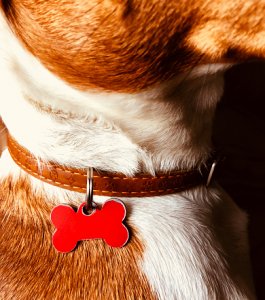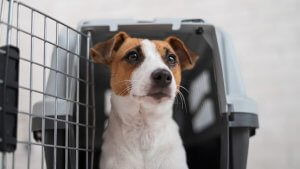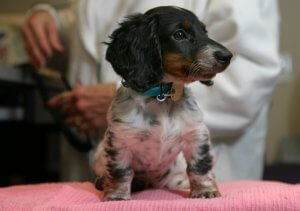If you plan to be traveling with your pet this summer, the Animal Medical Center of Streetsboro has put together some tips and tricks to help keep traveling with your pet safe and stress-free.
Make Sure Your Pet Has Proper Identification
 No matter where you are traveling to or how you travel there, you need to make sure your pet is microchipped for identification. You also want to make sure that your pet is wearing their collar with your name, phone number, and any other relevant contact information.
No matter where you are traveling to or how you travel there, you need to make sure your pet is microchipped for identification. You also want to make sure that your pet is wearing their collar with your name, phone number, and any other relevant contact information.
We also recommend that you place a temporary tag on their collar with your destination phone number and cell phone number for the length of your trip.
Tips for Traveling By Plane With Your Pet
Unless your pet is small enough to ride underneath your seat, we recommend avoiding air travel with your pets. If it is necessary to bring them along while flying, you will want to follow these tips:
Schedule a Veterinary Checkup
Before your trip, we recommend that you make an appointment for a routine checkup for your pet. This will ensure they are updated on all vaccinations and will allow you to obtain a health certificate from your veterinarian that will be dated within ten days of your trip.
During this appointment, our veterinarian can discuss ways that you can calm your pet before the flight in case they become anxious or afraid. If you are traveling outside of the U.S., be sure to check with the foreign office of the country where you are traveling for any additional planning or health care requirements.
Use a USDA-approved Shipping Crate
 Make sure the crate is large enough for your pet to comfortably stand, sit, and turn around. You will also need to place some type of bedding in the crate, such as towels or shredded paper, to absorb any accidents.
Make sure the crate is large enough for your pet to comfortably stand, sit, and turn around. You will also need to place some type of bedding in the crate, such as towels or shredded paper, to absorb any accidents.
You also want to tape a plastic bag of dried food into the crate, which will allow airline staff to feed your pet in case of a layover. You should also freeze a small water dish full of water. This will thaw out by the time they are thirsty during the flight. Keep the door securely closed, but do not lock it. Airline personnel needs to be able to access the crate if there is an emergency.
You also want to make sure the crate has proper identification. Be sure to make the crate with the words “Live Animal.” We also recommend you put your name, a photo of your pet, as well as your cell phone and destination phone number. We also recommend you keep a photo of your pet on hand while traveling in case they escape their crate.
Book A Direct Flight
Whenever possible, we recommend you book a direct flight when traveling with your pet. With a direct flight, you can reduce the chances that your pet is left on the tarmac during extreme weather or is mishandled by baggage staff during a layover.
Tips for Traveling With Your Pet By Car
If you are driving a long distance, there is more to traveling with your pet than just loading them into your backseat. Here are some tips to help you keep your pet safe out on the road:
Help Your Dog Get Used to The Car
Before a long trip, start by taking your pet on short drives and gradually increase the time they spend in the car. If you plan to travel across state lines, make sure you have your pet’s rabies vaccination record, as some states require proof at their interstate crossings.
Use Pet Carrier or Crate to Keep Your Pet Safe
Make sure the crate is large enough for the pet to stand, sit, and lie down. They should also be able to turn around in the crate. Secure the crate in the vehicle, so it doesn’t move when driving or coming to an abrupt stop. If you choose not to crate them, make sure your pet is secure by attaching their harness to the seat buckle. Do not allow them to ride with their head outside the window, as this could lead to injury.
Pack Your Pet a Travel Kit
When packing for your pet, make sure that you have a bowl, leash, food, waste bags and a scoop, medications, first aid, grooming supplies, and any important travel documents. You should also make sure to pack their favorite toy, blanket, or pillow. We recommend starting their feeding schedule a few hours prior to leaving with a light meal. Make sure to only give your pet bottled water as water from an unfamiliar area could cause an upset stomach.
Don’t Leave Your Pet Unattended in the Vehicle
Even if you leave the windows open, a vehicle can become as hot as a furnace on a hot day. When it comes to cold weather, the car can become like a freezer. Don’t put your pet at risk of heat stroke or freezing to death by leaving them in your vehicle unattended.
Schedule Your Pet’s Checkup Today!
At the Animal Medical Center of Streetsboro, we can help you prepare your pet for travel. Contact us today to learn more!
 Your pet reacts differently to allergies than humans do and will often show skin irritation. Here are some signs your pet may be suffering from an allergy:
Your pet reacts differently to allergies than humans do and will often show skin irritation. Here are some signs your pet may be suffering from an allergy: No matter where you are traveling to or how you travel there, you need to make sure your pet is microchipped for identification. You also want to make sure that your pet is wearing their collar with your name, phone number, and any other relevant contact information.
No matter where you are traveling to or how you travel there, you need to make sure your pet is microchipped for identification. You also want to make sure that your pet is wearing their collar with your name, phone number, and any other relevant contact information. Make sure the crate is large enough for your pet to comfortably stand, sit, and turn around. You will also need to place some type of bedding in the crate, such as towels or shredded paper, to absorb any accidents.
Make sure the crate is large enough for your pet to comfortably stand, sit, and turn around. You will also need to place some type of bedding in the crate, such as towels or shredded paper, to absorb any accidents. Spaying, also called ovariohysterectomy, is a surgical procedure where the ovaries and uterus are removed to sterilize a female dog. This will prevent the dog from being able to reproduce.
Spaying, also called ovariohysterectomy, is a surgical procedure where the ovaries and uterus are removed to sterilize a female dog. This will prevent the dog from being able to reproduce. You will also notice itchy skin with food allergies. Dogs will typically itch their paws or ears and may experience gastrointestinal symptoms with a food allergy. When it comes to environmental allergens such as mold, pollen, or dust, your dog may suffer from an atopic allergic reaction or dermatitis. Typically, these are seasonal allergic reactions where you may notice your dog itching their paws, ears, ankles, muzzle, underarms, around the eyes, etc.
You will also notice itchy skin with food allergies. Dogs will typically itch their paws or ears and may experience gastrointestinal symptoms with a food allergy. When it comes to environmental allergens such as mold, pollen, or dust, your dog may suffer from an atopic allergic reaction or dermatitis. Typically, these are seasonal allergic reactions where you may notice your dog itching their paws, ears, ankles, muzzle, underarms, around the eyes, etc. The holidays are full of tasty treats for humans, but many of them can be harmful to your pet. If you plan to give your pet treats over the holidays, make sure that they are formulated just for them. Some common holiday foods to avoid:
The holidays are full of tasty treats for humans, but many of them can be harmful to your pet. If you plan to give your pet treats over the holidays, make sure that they are formulated just for them. Some common holiday foods to avoid:
